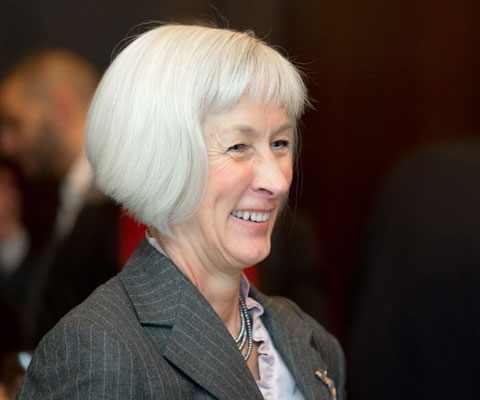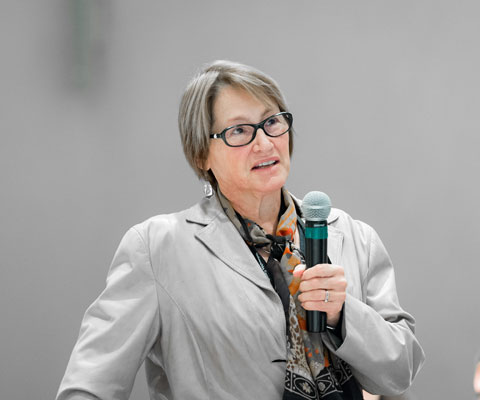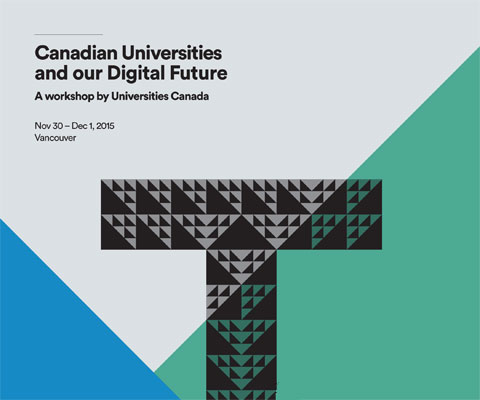Universities and future digital technologies
Around the world, new digital technologies are transforming organizations including universities.
Leaders from 25 Canadian universities participated in a Universities Canada workshop in Vancouver on November 30 and December 1, 2015 to discuss the trends, opportunities and challenges in leveraging digital technologies for research, university operations, and teaching and learning.
Digital futures workshop
Text on screen: [Digital Futures Workshop, Nov 30 – Dec 1, 2015, Vancouver; Universities Canada logo]
Text on screen: [Atelier sur les technologies numériques de l’avenir, le 30 novembre au 1er décembre 2015, Vancouver; logo Universités Canada]
Text on screen: [Open education resources, Vivek Goel, vice-president, research and innovation, University of Toronto; Universities Canada logo]
Vivek Goel: Imagine what the role of our faculty members becomes. And it is not to, to stand and lecture, it’s to create tools that enable our students to learn. And that the product of their work, just like their research publications, may be things that get posted in open educational repositories. And then we measure how many downloads they have, how often they get used by others. Think citation impact equivalent for open education resources.
Text on screen: [A metaphor for how we think about technology, Diana G. Oblinger, president emeritus, EDUCAUSE; Universities Canada logo]
Diana G. Oblinger: What I would like to ask you to do is to start out with maybe a different metaphor for how we think about technology. And that metaphor would be a combinatorial one. Many times, we think about technology and face to face as either or. It’s either personal or it’s impersonal. It’s good or it’s bad. And that no longer is enough. It’s really, what we’re seeing today is a combination of the physical and virtual in ways that we haven’t before.
And if you keep that metaphor in front of you as you think about technology and how to advance the sustainability and competitiveness of your institutions, I think you’ll be leaps and bounds ahead of where other people might be.
Text on screen: [Diverse pathways to achieving potential, John Baker, president and ceo, Desire2Learn; Universities Canada logo]
John Baker: Anyone know anyone that suffers from dyslexia? Okay. So all kinds of hands go up. There’s a font called Open Dyslexic. So in our system, you can literally change your font preference to Open Dyslexic and you can read the text 30% faster than you would normally be able to read the text. So there’s little things that we can do to embrace the personalization, to engage students, to help them overcome hurdles, if you will, in their learning.
And so, you’re right. We can have different pathways for students. So if one wants to just simply to read the content, they can read it. If they really like game-based learning, they can go through a game and spend hours playing the game. So the more that we can provide different pathways for these students, the more students that we’ll actually help achieve their full potential.
Text on screen: [Universities Canada bilingual logo. The voice of Canada’s universities. univcan.ca]
Imagining the “smart campus” of the future
Diana Oblinger, president emeritus of EDUCAUSE, encouraged senior university leaders to consider a different metaphor for thinking about technology. Rather than viewing technology and face-to-face interaction as mutually exclusive opposites, leaders should embrace a combination of the physical and virtual to engage both those within and outside the university and to increase universities’ competitiveness and sustainability.

“The integration of the digital and physical are creating new ways to engage.”
Impacts and opportunities in teaching and learning
Participants emphasized that for today’s job market, students need to be digitally literate: able to use digital technologies to effectively access, evaluate, create and communicate information.
Speakers and panelists highlighted the following key digital disruptors, trends and opportunities in teaching and learning at universities today.
- Student success through analytics
- Mentored online experiential learning
- Outcomes-based learning
- Combination of online courses and workplace practicums
- Digital technologies for outreach to communities at home and abroad
- New fee models

Students learn in many different ways. We need to transform ourselves to make sure we provide students with various types of experiences (including experiential learning opportunities) and not just lecture, as they can now download content from anywhere.

Equipping students with the environment and infrastructure they need to develop their innovation potential is now an essential element of a university education. These are the generations that will carve Canada’s innovation future.
The emerging research and innovation ecosystem
The current digital research infrastructure ecosystem in Canada is complex and fragmented. The federal government is carrying out consultations to develop on new “Digital Research Infrastructure” strategy and Universities Canada is providing input in this process.
Speakers concluded that:
- We should not aim for a perfect strategy but rather one that will advance the “Digital Research Infrastructure” agenda.
- Creating the human infrastructure required for data management, curation and discoverability, due to the diversity of data will be a challenge.
- Clear and defined data management principles and requirements will be important in the future for provinces, the federal government and institutions.
- Systems will need to be created that allow for the cross-disciplinary linking of data.
- More shared digital infrastructure in Canada would be beneficial. As one participant said, “we need to stop competing on research infrastructure so we can compete in research.”
- The various institutions and organizations involved in university research need to continue to coordinate and work collectively at the national level.
Data management is arguably going to be the toughest nut to crack.
Emerging trends in digital research and scholarship
Every field of scholarship is being transformed by analytics and open access, which is making data and research results more widely available.
The world’s most pressing problems are now being addressed through very large online collaborations involving researchers, students and other professionals from Canada and around the world.
Large companies and NGOs are carrying out large-scale research and offering research prizes to individuals and teams to solve scientific problems.
The use of crowdsourcing volunteerism is on the rise as is high performance computing.
Fostering innovation
A growing number of universities are housing incubators to nurture and support students’ innovations.
This raised several issues:
- How should tenure and promotions be adjusted for the digital era?
- How can Canadian universities better leverage collective intelligence from on and off campus to improve discovery?
- How might high-performance computing affect research?
Optimizing operations
University presidents’ reflections
- Technologies are impacting the way institutions do business.
- New technologies raise new expectations.
- Technologies must be viewed as tools to help achieve the university’s various strategic objectives.
- It is highly beneficial to have an IT advisory committee comprised of the Chief Information Officer and representatives from faculty, students and even representatives from outside the university.
- University leaders will use analytics more often to drive decision-making in teaching and learning, recruitment, fund-raising and resource optimization.
- There is a need for more opportunities to share best practices and models in digital technologies.
Digital needs to be supported by a strong governance structure, be user-centred and agile, be based on a vision that motivates users, and be accountable and sustainable.
Shaping our digital future
Universities will continue to incorporate digital technologies to attract more students, support their success, engage students in new ways, cater to their learning styles and needs, and better prepare them for their future careers.
They will also use digital technologies to support a robust research environment involving online collaboration and access to increasingly large data sets and high performance computing networks.
And they will use technologies to offer a more secure, effective and efficient administrative environment including improved student services.

